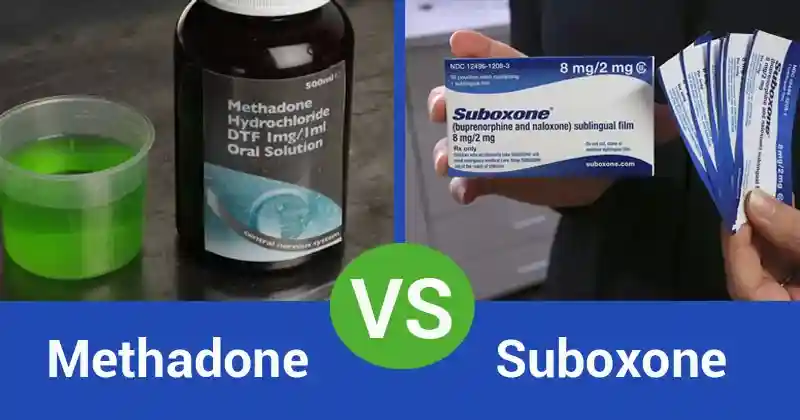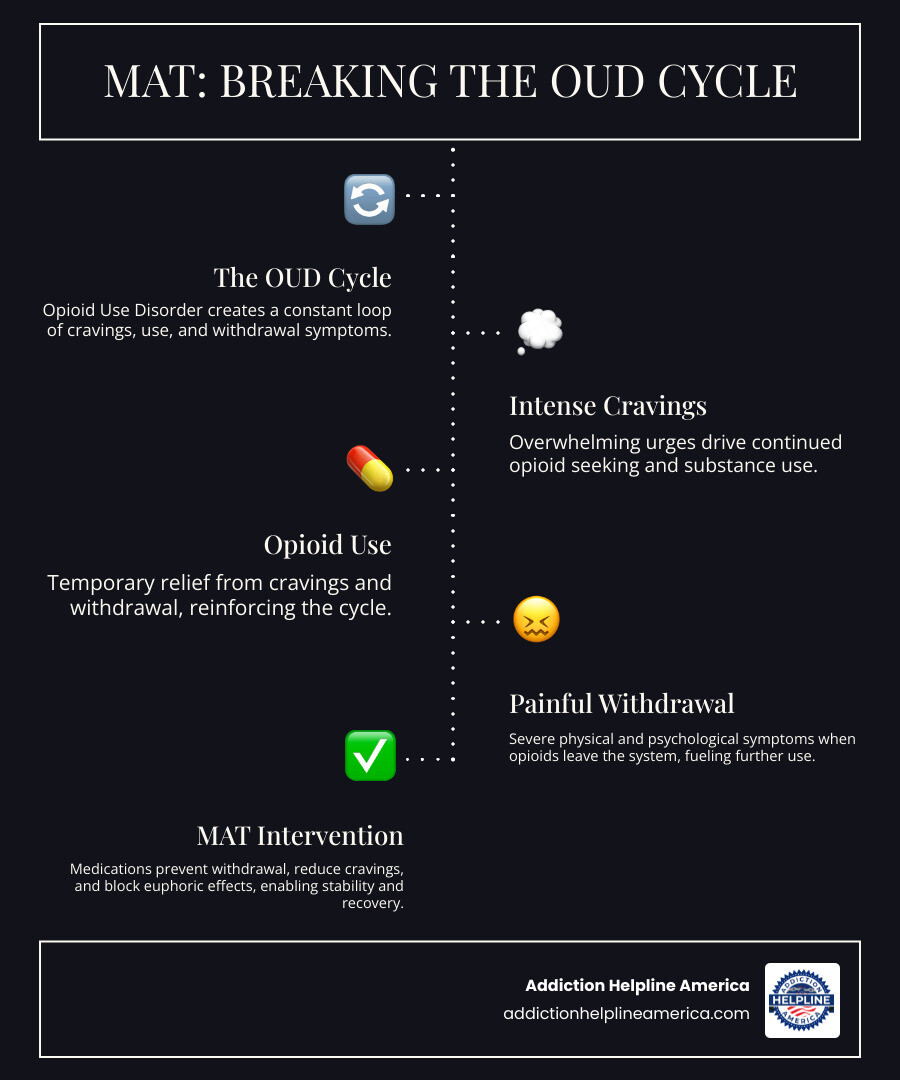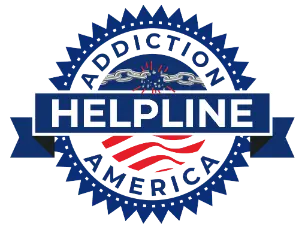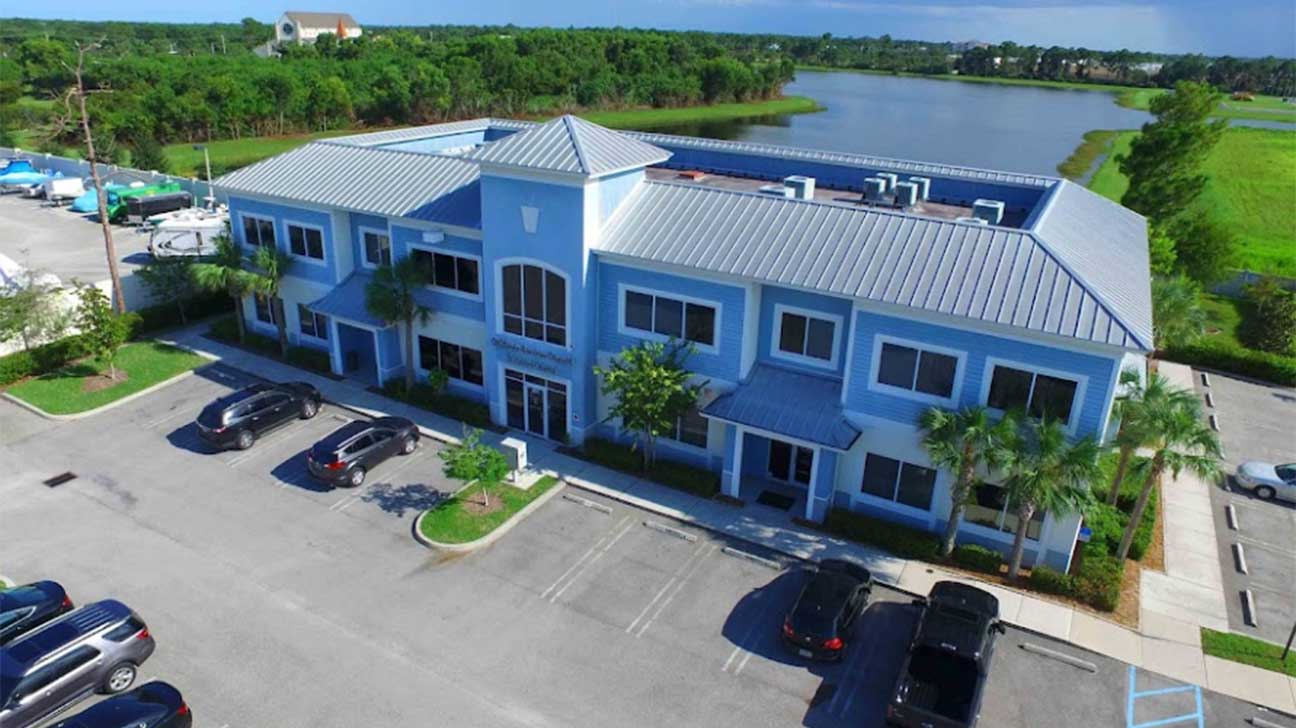
Understanding Your Treatment Options for Opioid Use Disorder
Methadone suboxone clinics offer medication-assisted treatment (MAT) to help people recover from opioid addiction. Here’s a quick overview:
Quick Comparison:
| Treatment | Type | Where to Get It | Typical Duration |
|---|---|---|---|
| Methadone | Full opioid agonist | Specialized clinics only (daily visits) | 12-24 months average |
| Suboxone | Partial agonist + antagonist | Doctor’s office or clinic (can take home) | 3+ months, varies by person |
Key Facts:
- Both medications are proven effective at reducing opioid use, overdose deaths, and cravings.
- Provincial guidelines often recommend Suboxone as first-line therapy due to lower overdose risk.
- Methadone remains highly effective, especially if Suboxone isn’t a good fit for you.
- Treatment is most effective when combined with counseling and support services.
- Detox alone is not an effective treatment; relapse and overdose risk are much higher without medication.
Opioid use disorder is a medical condition requiring medical treatment. Opioid agonist treatment (OAT) uses medications like methadone and Suboxone to prevent withdrawal, reduce cravings, and provide the stability needed to rebuild your life.
Studies confirm that both methadone and Suboxone significantly reduce overdose deaths. A 2014 study found both more effective than placebos for treatment retention, reducing illicit drug use, and preventing death, with methadone showing a slight edge in keeping people in treatment. The best choice depends on how they work, where you get them, and which fits your life better.
At Addiction Helpline America, we guide individuals and families to find effective methadone suboxone clinics. Our team connects you with compassionate, evidence-based care custom to your needs, insurance, and location. Let’s explore what you need to know to make an informed choice.

Methadone vs. Suboxone: A Detailed Comparison
When exploring methadone suboxone clinics, you’ll encounter two primary medications: methadone and Suboxone. Both are proven to help people recover from opioid use disorder, but they work differently.
Methadone is a full opioid agonist, meaning it fully activates the brain’s opioid receptors. Suboxone contains buprenorphine, a partial opioid agonist, which only partially activates these receptors. This creates a “ceiling effect” where taking more doesn’t increase the effect, significantly reducing overdose risk.
Suboxone also contains naloxone, an opioid antagonist. When taken as prescribed (under the tongue), the naloxone has little effect. If injected, however, it triggers immediate withdrawal symptoms, acting as a deterrent against misuse.
How Methadone Works and Its Benefits
Methadone binds to opioid receptors, preventing the euphoric rush from illicit opioids while stopping cravings and withdrawal symptoms. It provides a stable level of medication in your system, ending the cycle of highs and lows. This stability gives you the mental and physical space to focus on recovery.
Methadone Maintenance Treatment (MMT) has helped countless people rebuild their lives. Research shows it dramatically reduces risky behaviors, opioid use, and criminal activity. Programs like Methadone Maintenance Treatment Program Clinics offer structured environments for this proven treatment.
Potential Risks and Side Effects of Methadone
Methadone is a powerful Schedule II substance, carrying a risk of dependence and misuse. This is why it’s tightly regulated, typically requiring daily visits to specialized clinics. Common side effects include drowsiness, dry mouth, constipation, and nausea.
More serious but less common risks include slowed breathing (respiratory depression) and irregular heartbeat. Long-term use may contribute to liver injury, underscoring why close medical supervision is essential. Your doctor will monitor you to find a dose that is both stable and safe.
How Suboxone Works and Its Benefits
Suboxone’s buprenorphine satisfies the brain’s need for opioids enough to prevent withdrawal and cravings without producing intense euphoria. The naloxone component is a safety feature to deter injection.
One of Suboxone’s biggest advantages is its lower overdose risk due to the ceiling effect. Studies show people on Suboxone have up to 45% fewer emergency room visits compared to those not in treatment.
Suboxone also offers greater convenience. Unlike methadone, it can often be prescribed by a doctor for at-home use, offering flexibility for work and family life. Suboxone Treatment Centers combine this medication with comprehensive support services.
Potential Risks and Side Effects of Suboxone
As a Schedule III substance, Suboxone has a lower potential for misuse than methadone, but risks still exist. Common side effects include headaches, dizziness, trouble sleeping, and difficulty concentrating.
The biggest concern is precipitated withdrawal, which occurs if Suboxone is taken too soon after other opioids. The naloxone can trigger sudden, intense withdrawal symptoms, but this is avoidable with proper medical guidance.
Rarely, Suboxone can cause serious issues like serotonin syndrome, a dangerous condition requiring immediate medical attention. This highlights the importance of professional oversight.
Key Differences in Treatment
When choosing between options at methadone suboxone clinics, practical differences are important.
- Administration: Methadone requires daily supervised visits to a clinic initially. Suboxone is usually prescribed for home use after a stabilization period.
- Treatment Duration: Methadone treatment often lasts a minimum of 12-24 months. Suboxone treatment can be shorter (3+ months), but many benefit from longer-term use.
- Cost & Coverage: Methadone is often covered by government programs and insurance. Suboxone coverage varies by prescription plan.
- Pregnancy: Both are considered safe. Methadone has a long history of use, while Suboxone is associated with favorable outcomes.
- Accessibility: Methadone is only available at licensed Opioid Treatment Programs. Suboxone can be prescribed by a wider range of certified providers.
| Feature | Methadone | Suboxone (Buprenorphine/Naloxone) |
|---|---|---|
| Chemical Type | Full opioid agonist | Partial opioid agonist + Opioid antagonist |
| Mechanism | Fully activates opioid receptors; blocks euphoria; prevents withdrawal | Partially activates receptors; reduces cravings/withdrawal; naloxone deters misuse |
| Administration | Daily liquid or tablet at specialized clinics | Sublingual film or tablet, typically taken at home |
| Misuse Potential | Higher (Schedule II) | Lower (Schedule III) |
| Overdose Risk | Higher, especially with other depressants | Lower, due to ceiling effect |
| Treatment Duration | Typically 12-24 months minimum | 3+ months, often longer |
| Cost & Coverage | Often covered by insurance and government programs | Requires prescription; coverage varies |
| Pregnancy | Extensive safety data available | Associated with favorable maternal and neonatal outcomes |
| Accessibility | Limited to licensed treatment programs | Available from certified prescribers in various settings |
Neither medication is inherently better. The right choice depends on your medical history, severity of use, and personal circumstances. Personalized guidance is key to finding the right fit.
Comparing Effectiveness and Clinical Guidelines
When considering treatment, you’re likely wondering which option works better. The good news is that both methadone and Suboxone are highly effective for opioid use disorder. The goal is to find what works best for you.

A major 2014 study confirmed that both methadone and buprenorphine (the active ingredient in Suboxone) were significantly more effective than placebos. Patients in the study stayed in treatment longer, used fewer illicit drugs, engaged in less criminal activity, and had a lower risk of death.
The study also found that methadone had a slight edge in keeping people engaged in treatment. The daily structure of a clinic can provide a strong anchor, especially in early recovery.
Crucially, both methadone and buprenorphine consistently reduce overdose deaths compared to approaches like detox alone. Choosing medication-assisted treatment at methadone suboxone clinics is a choice that has been proven to save lives.
So what do the experts recommend? Provincial guidelines in Canada and many clinical standards suggest buprenorphine/naloxone (Suboxone) as the first-line therapy for most people. The primary reasons are its lower risk of overdose, fewer side effects, and fewer dangerous drug interactions.
However, methadone remains a vital treatment option. Methadone is particularly recommended if Suboxone is ineffective or causes adverse effects. For those with a history of high-dose opioid use, methadone might provide the necessary level of support. Every person’s chemistry is different, and needing the stronger support of methadone is a valid medical path.
For pregnant individuals with opioid use disorder, both medications are safe and effective. Buprenorphine is often associated with more favorable outcomes for babies and mothers, making Suboxone a common choice for starting treatment. However, continuing with methadone if already stable is also a safe, well-established approach. A doctor can help determine the best choice for your situation.
At Addiction Helpline America, we’ve seen people succeed with both medications. The best treatment is the one that fits your life and gives you the stability to recover. We can help you find methadone suboxone clinics that offer the compassionate, evidence-based care you deserve.
How to Find Methadone Suboxone Clinics
Finding the right methadone suboxone clinics is a crucial step, but it doesn’t have to be overwhelming. You are looking for a place of support, understanding, and high-quality care.

Start by speaking with a doctor or healthcare provider. They can assess your situation, discuss whether methadone or Suboxone is a better fit, and provide referrals. While Suboxone can be prescribed by many authorized doctors, methadone requires a specialized Opioid Treatment Program (OTP).
When evaluating clinics, consider these factors:
- Accreditation: Ensure the clinic is licensed and meets high standards of care.
- Comprehensive Services: Look for programs that offer counseling, therapy, and support groups.
- Location and Accessibility: Consider the practicality of getting to the clinic, especially for daily methadone visits.
- Cost and Insurance: Understand what your insurance covers and what assistance programs are available.
- Staff Expertise: You deserve a team that understands opioid use disorder and evidence-based treatment.
National and State-Level Directories
Addiction Helpline America is here to simplify your search. We provide free, confidential guidance to connect you with a suitable program from our extensive network. You can begin by exploring our Addiction Helpline America Clinic Directory to find facilities in your area.
National resources like the Substance Abuse and Mental Health Services Administration (SAMHSA) also offer valuable tools. Their Opioid Treatment Program Directory and Buprenorphine Practitioner Locator can help you find accredited clinics and prescribers across the U.S.
Many states also provide their own directories. The Addiction Helpline America website offers state-specific guides to help you understand local options, including insurance information and program types.
What to Expect at Methadone Suboxone Clinics
Knowing what to expect can ease the anxiety of a first visit. The process typically begins with an intake appointment for a thorough physical and mental health evaluation. Staff will ask about your substance use and medical history to create a safe and effective individualized treatment plan.
Dosing procedures vary. For methadone, you’ll receive your daily dose at the clinic, eventually earning take-home privileges as you stabilize. For Suboxone, you may receive your first dose at the clinic but will typically transition to taking it at home with regular follow-up appointments.
Counseling is a fundamental part of treatment. You’ll participate in individual or group therapy to address the underlying causes of addiction, learn healthy coping skills, and build a foundation for long-term recovery.
Facilities like Medmark Treatment Centers exemplify comprehensive care by combining medication with therapeutic support. This integrated approach offers the best chance at lasting recovery.
Reaching out for help is a sign of strength. Addiction Helpline America is here to connect you with the care you deserve.
The Importance of Comprehensive Care
Medication is a powerful tool, but it’s not the whole story. The best methadone suboxone clinics understand that medication creates a stable foundation, but long-term success depends on what you build upon it. Recovery is about rebuilding your life.

-
Counseling plays an essential role. With cravings managed, you have the mental space to address the root causes of addiction. Therapies like Cognitive Behavioral Therapy (CBT) help you change thought patterns that lead to substance use.
-
Peer support creates connection and combats the isolation of addiction. Support groups bring together people with shared experiences, helping you realize you are not alone in your struggle. This shared understanding is a powerful tool for recovery.
-
Case management addresses practical barriers to recovery, such as housing, employment, or legal issues. A case manager connects you with resources so you can focus on healing.
-
Relapse prevention strategies give you tools for the long haul. Your treatment team will help you identify triggers and develop a crisis plan to manage cravings and build a strong support network.
-
Harm reduction saves lives. Because relapse can happen, programs provide Take Home Naloxone kits. Naloxone rapidly reverses opioid overdoses and can be the difference between life and death.
-
Co-occurring mental health conditions need simultaneous treatment. Depression, anxiety, and PTSD often coexist with opioid use disorder. Effective clinics screen for and treat these conditions as part of a holistic care plan.
This comprehensive approach is what separates Opioid Agonist Treatment (OAT) from detoxification alone. Studies show that detox alone is not an effective treatment for opioid use disorder. When you stop opioids abruptly, your tolerance drops quickly. If a relapse occurs, the risk of a fatal overdose is extremely high. Most people who go through detox without OAT will relapse—this is a biological response, not a failure of willpower.
OAT provides the stability and breathing room needed to do the real work of recovery. The medication doesn’t do the work for you, but it makes the work possible.
At Addiction Helpline America, we connect you with programs that accept this whole-person approach, giving you the best chance at a life beyond addiction.
Frequently Asked Questions about Methadone and Suboxone Treatment
When considering treatment for opioid use disorder, it’s natural to have questions. Here are answers to some of the most common concerns we hear at Addiction Helpline America about methadone suboxone clinics.
Is methadone or Suboxone better for treating opioid addiction?
There is no single “better” medication; the most effective treatment is the one that helps you recover. The choice depends on your unique needs. Factors include your medical history, the severity of your addiction, and lifestyle considerations. For example, methadone may be better for long-term, high-dose use, while Suboxone offers more flexibility and a lower overdose risk.
Practical factors, like your ability to visit a clinic daily for methadone versus taking Suboxone at home, are also key. As noted, clinical guidelines often suggest starting with Suboxone due to its safety profile, but methadone is a crucial option if Suboxone isn’t effective for you. A consultation with a doctor is the best way to determine the right path.
How long does treatment at methadone suboxone clinics last?
The timeline for recovery is personal and varies for each individual. For methadone, treatment typically lasts at least 12 months, with many people benefiting from 12 to 24 months or even longer-term maintenance. This isn’t a sign of failure; it’s effective medical treatment that provides stability.
Suboxone treatment duration is also flexible. Some may use it for a few months, while many others require maintenance for a year or more. The goal is to achieve genuine stability, not to rush off the medication. Any decision to reduce your dose must be done gradually under medical supervision to avoid withdrawal and reduce relapse risk.
Can you become addicted to methadone or Suboxone?
It’s important to distinguish between physical dependence and addiction. Your body will become physically dependent on methadone or Suboxone, meaning you would experience withdrawal if you stopped suddenly. This is a normal, expected physiological response to the medication.
Addiction, however, is defined by compulsive drug-seeking and use despite harmful consequences. When used as prescribed, methadone and Suboxone manage your addiction to other opioids—they don’t create a new one. They stabilize brain chemistry, allowing you to function normally without chasing a high.
Their misuse potential differs. Methadone (Schedule II) has a higher potential, which is why it’s tightly regulated. Suboxone (Schedule III) has a lower potential due to its partial agonist properties and the inclusion of naloxone, which deters injection. Taking these medications as prescribed is medical treatment, not a substitute addiction.
Conclusion: Taking the Next Step Towards Recovery
Understanding your options is a vital step toward recovery. The choice between methadone and Suboxone is about finding the right fit for your unique situation.
Methadone is a full agonist offering powerful stability, often with daily clinic visits. Suboxone is a partial agonist with a lower overdose risk and more flexibility for at-home use. Both are proven to save lives by reducing cravings and preventing withdrawal.
You don’t have to make this decision alone. At Addiction Helpline America, we provide free, confidential, and personalized guidance to help you steer your options. Finding the right methadone suboxone clinics can be overwhelming, but our team is here to listen and connect you with a program that fits your needs, insurance, and location.
Research confirms that medication-assisted treatment, combined with comprehensive care like counseling and peer support, is highly effective. It dramatically reduces overdose deaths and helps people rebuild their lives. You deserve that chance.
Whether you’re ready to start or just exploring options for yourself or a loved one, we can help. Browse our directory to find a methadone clinic for you or a Suboxone center, or contact our team today. Recovery is possible, and we’re here to help you take the next step.
Our helpline is 100%
free & confidential
If you or someone you care about is struggling with drug or alcohol addiction, we can help you explore your recovery options. Don’t face this challenge alone—seek support from us.
Programs
Resources
Will my insurance
cover addiction
treatment?
We're ready to help
Find the best
drug or alcohol treatment
center
Are you or a loved one struggling with addiction? Call today to speak to a treatment expert.












